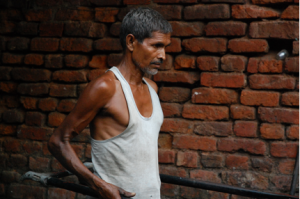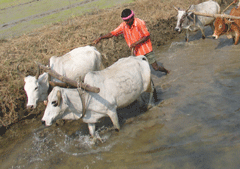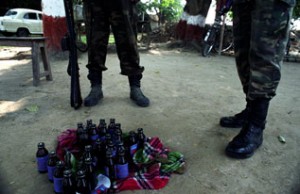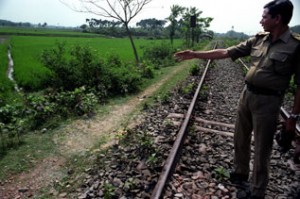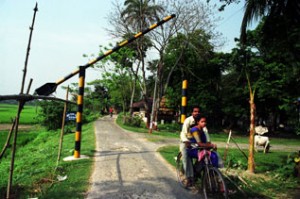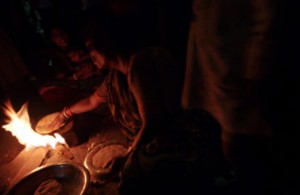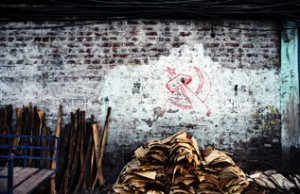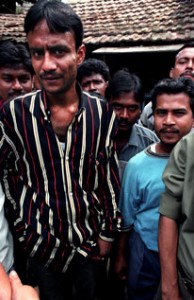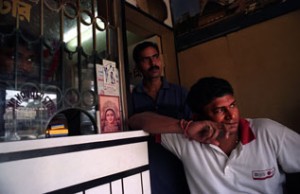By Becky Palmstrom (class of 2011)
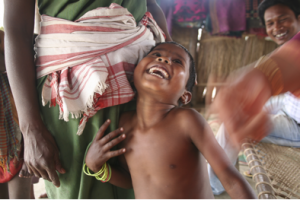 ASSAM, India, April 2010—Khagel Barman was famished as he headed down a dirt path towards his home, a turquoise adobe house, sat on the green plains of Assam, in North East India. The twenty-year old directed the cows ahead of him and carried a woven sack over his shoulder. The sack bulged with the potatoes he’d spent the day gathering. The dying sunlight lit up the lush leaves and tilled fields he trudged. It was just after 6pm and it would be Khagel’s last sunset.
ASSAM, India, April 2010—Khagel Barman was famished as he headed down a dirt path towards his home, a turquoise adobe house, sat on the green plains of Assam, in North East India. The twenty-year old directed the cows ahead of him and carried a woven sack over his shoulder. The sack bulged with the potatoes he’d spent the day gathering. The dying sunlight lit up the lush leaves and tilled fields he trudged. It was just after 6pm and it would be Khagel’s last sunset.
Khagel lived with his family in a region of India crammed between China, Burma and Bangladesh. This triangle of earth is attached to mainland India by a sliver of earth barely 15 kilometers wide. As multi-ethnic as Afghanistan or the Balkans it is not without similar troubles and although India’s conflict over Kashmir and the clashes with the Naxalites garner more headlines, the seven sister states of the North-East of India have some of the most stubborn and bloody insurgency movements in the country. There are some 130 different armed groups here: sometimes fighting for an ideology, sometimes for an autonomous ethnic homeland, sometimes for complete independence and sometimes because there is no other way to make a living. Over the years more and more groups have turned to extortion, “taxing” civilians and exploiting the vacuum of law and order to grow stronger. In some areas, like the state of Manipur, the war economy is so rooted it has become the main employment opportunity for young people.
Although this is a place wracked by ethnic conflict and where many are resentful of the Indian state, there had been little violence in the area surrounding the Barman’s house before that day in 2000 when Khagel, a second year art student, walked home with his sack of potatoes.
As Khagel ambled into his home’s small courtyard he greeted his father, a thin, bony man, who sat at the doorway watching the darkness settle. Khagel washed the grime of the fields off his face and out of his thick black hair and bushy moustache. He called to his mother for dinner and she started preparing rice. Khagel’s friend from Art College had stopped by to watch that night’s cricket match between India and Pakistan.
As 7 pm drew closer, the courtyard filled with Muslim worship songs from the television set, the clucking of chickens and the noise of the cricket commentary. It was the sound of the two cars that made Khagel’s father, Garnesh, look up from his place in the courtyard. The vehicles had stopped at the gate Khagel had just entered. Sixteen police officers and masked men got out.
The men were part of India’s policy to stamp out armed activities in Assam. Although the armed groups are responsible for human rights violations, the Indian state’s attempts to quell the insurgency also cause violations. The North East is currently the only area other than Kashmir, where an old British law is used to arrest, detain and shoot those “suspected” of insurgency. Under the law, no military personnel can be held accountable for their actions without permission from the Central government; offering immunity and some say, promoting impunity, even when, as in Khagel’s case, they get the wrong person.
“They were like this,” Khagel’s father Garnesh explains ten years later, taking a white and red faded scarf from his neck and wrapping it over his nose and mouth illustrating the masked men who visited that day. The men called out for Khagel and before his father could answer, Khagel stood facing the men.
“Yes, I am Khagel Barman,” he said.
Nilima, Khagel’s mother heard the scrunching of boots and voices of the men in the courtyard and abandoned the rice she was washing to ask what the men wanted from her son.
“You don’t know your son,” one of the policemen said. “You don’t know what your son has been doing.”
But all Khagel had been doing was running meetings and participating in student politics at the local Art College. According to family, friends and even local policemen, he had never been involved in armed activities. The Unified Command structure in Assam extends AFSPA to cover police working with the army against so-called terrorists. In the courtyard of the Barman’s turquoise house the physical ramifications of the Act played out.
One of the policemen pushed Khagel roughly into the dirt and kicked him in the stomach.
“They put their foot to his head.” Garnesh says, standing up to illustrate the raised foot crushing down onto the head of a Khagel who now only exists in the memories of his parents.
The chickens had stopped clucking, his parents remember. Nilima rushed forward screaming for them to stop. They didn’t. Instead she and other members of the family were shoved into a room off the courtyard. The door was bolted and the family watched through the gaps in the bamboo walls as the men lined up with their guns pointed towards Khagel.
“They took him to one side of the courtyard and they asked him to stand, like this,” Garnesh says, pointing out the scrap of earth where it happened. Then Garnesh describes the sound of the twenty-seven bullets that broke the skin of Khagel and Garnesh and Nilima’s world.
“The arm was separated because there were so many bullets,” Garnesh illustrates the strangled look of Khagel’s body as first his arm came off and then he fell. The men emptied Khagel’s sack of potatoes out onto the ground and stuffed his still warm body into the sack. Nilima says she doesn’t know what happened next – she blanked out.
Ten years have gone by and she sits in the room where her son spent his last minutes. Her back is poker-straight as though she might break into fragments if she makes a sudden move. There is a portrait of her dead son staring down at us from the wall. The turquoise paint is faded.
It is hard not to see this family entirely through the prism of their son’s death – an injustice that bleeds into every part of their reality: from the poverty they face without a son to support them, to the smudged sadness at the edges of their eyes. Despite an apology from members of the police in the weeks after their son’s death and promises of compensation, none of the police involved in the murder of Khagel Barman have faced trial. It has taken ten years for the compensation to come through. Anjuman Ara Begum, a researcher with Asia Human Rights Commission, says although the number of people killed by the state has fallen, abuse of the Armed Forces Special Powers Act in Assam and Manipur continues.
Begum has spoken with over 70 families who have lost their loved ones in incidences similar to the Barman’s. She says more than 90 percent of the families have received no compensation for their loss.
AFSPA is the residue of Britain’s time in India and was once used to control “disturbed” areas of the country. In 1958 the Indian state resurrected AFSPA to quell an uprising in the Naga Hills in the north of the region. Way before 9/11, India, the largest democracy in the world, was using anti-terrorist legislation in its North East. The hill tribes on the border of Burma and China have always been easy to define as “disturbed” – they have always been fiercely dependent – yet the struggles of the armed groups in this region have remained off the international agenda and mainly ignored by the media. AFSPA is just one part of the culture of impunity in the seven sister states, where 230 ethnic groups fight to be heard.
On the heavily militarized border between Bhutan and India violations committed by non-government forces show the complexity of the North-Eastern conflicts and one of the reasons why a blanket repeal of AFSPA is unlikely. Here the rainy season has begun and the weather can’t seem to make up its mind, flipping between sharp sunlight and brutal hailstorms in minutes. The stories are familiar in a region where ethnic identity and territory have been intrinsically linked – as though claiming a homeland is the only way of claiming a voice.
I am in the heartland of one of the ethnic groups, the Adivasi, four hours north-west of the Barman’s in an area known as Boroland. The colors of the Adivasi women’s clothes are all the brighter for existing in a cluster of houses that look as though they might disappear under a plane of mud. The mud morphs from cracked desert to a clay-like swamp as the hailstorms begin. The women are constantly getting up to brush the mud out of their homes (whose floors are themselves made of the stuff). These are some of the internally displaced. They now live as strangers in their own land, without access to clean water, schools or adequate food.
Boroland is an autonomous council in the state of Assam. For years Boro armed groups fought for greater autonomy. Finally in the early 2000’s the Indian government relented and agreed that in the areas where the Boro population was at least 50 percent an autonomous council would be created to administer their own affairs. The Assam state government estimates two thousand people were killed as the Boro re-arranged the ethnic landscape.
“Before we were living a very peaceful life,” says a woman dressed in the bright green woven scarf typical of this area. “I do not know how it could have happened that our neighbors did this.”
“First they would come and take our buffalo,” she says, “Then they would come to our house and shoot us. They cut people into pieces.”
Almost 200,000 people were displaced.
“They burnt the 80 houses in our village, one after the other,” another woman nursing a baby chimes in. “If we tried to save anything from our home they took us and threw us to the ground.”
“We ran to the border and lived for three days without food or water,” she continues. “Now we cannot go back to our land. The Boro live there now.”
The women are talking over each other, arguing or disagreeing or correcting each other as the translator tries to keep up.
“My husband was beaten so badly last time that he can no longer work, his arms were too broken,” says one woman, while another illustrates the beating, standing and whacking her scarf over and over again on a stone in the middle of the muddy center of their village – “bang bang bang” she yells and the group of women laugh at her impersonation.
“Everybody is asking for a separate state,” says an old woman, laughing. “How will it work?” Others mutter in agreement. “We cannot build our houses properly because we do not know when we will have to leave again.”
“For a year or so they have stopped coming and killing,” says another. “But you never know when it will happen again.”
It is not only the Adivasi who were displaced. The Rajbongshis, the Muslims, the Nepalis and the Sutraohars also lost their land and therefore the ability to farm.
There is a mixed response when I ask the women about the Armed forces and the police. In some of the communities we visit, the women tell me the military has been helpful.
“They used to come to our village and protect and help us,” says one woman. “There was one police officer, he was very helpful. We wouldn’t have land if it wasn’t for him.”
While the world ignores the conflicts in the far North-East of India AFPSA is just one part of a complicated, violent series of relationships that steal security and life from civilians. Putting the blame on the shoulders of any one entity is a complicated, political and often dangerous process. In Boroland a few months ago a group of students crept out in the dead of night to paint “No Arms in Boroland” on a wall in the city. They were found by one of the military groups who told them they would be shown what no arms in Boroland looked like. The student’s arms were so badly cut they had to be hospitalized.
Although Meenakshi Gang, the Indian researcher for Human Rights Watch says rights are violated on all sides of the conflicts in the seven sister states the presence of AFSPA in some of the states for nearly six decades has not only led to widespread human rights violations, but has also created a mobilizing tool for the armed groups.
“The law has been so widely abused that it has now become a symbol of hate in places like Manipur and Assam,” she says, which is why even a recent Indian government commission examining the Act recommended its repeal.
However, the Indian army is yet to be convinced. They claim the Act is a necessary tool for protecting civilians. An Indian army officer expresses a commonly held view.
“If you are saying that one misuse merits a repeal – it is like saying because of the government’s misuse of election laws we should get rid of democracy,” he says, emphasizing the importance of seeing the law in a context of battle, where split second decisions are part of daily life.
The officer spent several years fighting under AFSPA in the state of Manipur and asked not to be named for this piece.
“Look it is one violation in 100,000 acts. Once in a year by one random person,” he says. “You cannot fall into the trap of making a mountain out of a molehill.”
I think about one woman in Manipur who started a hunger fast after the Indian army mowed down ten people at a bus stop in the capital, Imphal. Her name is Irom Sharmila. Soon after Sharmila’s hunger strike began in 2000 the Indian government arrested her through another leftover British law, which charged her with “attempting to commit suicide.” She has been in and out of army custody ever since, where lentil soup is forced through her nose to keep her alive. She says she will not let food or liquid pass her lips until the government of India repeals AFSPA.
I ask the officer about the massacre that inspired Sharmila’s fast: In November 2000 on a road outside of Imphal, a bomb went off near a military truck. The Assam Rifles’ unit on board the truck let loose. They shot indiscriminately until ten people were dead. What about them?
“Now I don’t know this precise case, but sometimes, if innocent people die it is collateral damage,” the officer says. “It is an unfortunate event. But what about these illegal acts [committed by the armed groups] that cause collateral damage? They are far more abusive of power.”
“We should not work on repealing the act, but on ensuing it is used properly,” the officer says.
He also says that despite the provisions no law gives the army the power to shoot without cause. It is an argument that Colin Gonsalves of the Human Rights Law Network also makes, “No law actually gives anyone the right to take life. But because of that impression people will not litigate or file cases against the police and the armed forces.”
The controversy over the Act also lies in whether it actually curbs violence or exacerbates it and there are people who speak on both sides. Alhi Ahmed at the Institute for Defense Studies and Analysis, a think tank that advises the Indian government, describes a period of 6 months when the Act was repealed in parts of Imphal, the capital of Manipur. There was an increase in violence, he says.
But those who oppose the act, like Binalakshmi Nepram, a friend of Sharmila’s and head of the Manipur Gun Survivors Network, the act has not helped fight insurgency either.
“It is not getting better, we have had the act for 50 years and there is more insurgency than ever,” she says. In Nepram’s state of Manipur, violence and corruption have sunk into every institution and business relationship. Both Catholic priests and doctors from Manipur told me they had no option but to pay bribes to the armed groups, the police and local authorities – when they stood on principal and refused to pay priests were shot dead and hospitals were bombed. Electricity in the capital, Imphal lasts only 4 or 5 hours a day, HIV rates are the highest in India and no one goes onto the street after 6 pm: it is too dangerous. But even within this context of insecurity Nepram still argues that AFPSA is not the answer and should be repealed. “If innocents are dying then who are you protecting?” she says.
However, in a place where running a school or selling rice requires payment to the local armed groups it is clear that solving tensions here will be tough and the need to reign in the army must be matched by reigning in the military groups.
No single actor, either state or non-state, has a monopoly on atrocities. Four hundred and sixty seven people, 64 of them civilians were killed in military operations in Manipur last year, reported the South Asian Terrorist Portal. Human rights activists, like Babloo Loitangbam of Human Rights Alert say that many of these were innocent people killed by the law Sharmila starves to repeal. Though those who know her well say her act of non-violent protest calls for a holistic notion of peace beyond just the repeal of AFSPA.
A picture of her stares down at me from the wall of a community NGO project in Boroland. A man from Manipur tells me that he thinks Sharmila is a saint, another in Assam talks about her as “a true Ghandian”, a conservative journalist and a member of the Indian government’s official think tank both say she should be given the Nobel Peace price, while Binalakshmi Nepram, a friend of Sharmila’s and head of the Manipur Gun Survivors Network says, “she is one of the most pure people I’ve met in my life.”
It seems Sharmila is not only a person, but also an idea. As Deepti Priya Mehrotra, author of Sharmila’s biographer, “she makes me question myself and what I am doing. Why I am not doing what she is doing.” AFSPA is one tiny cut on a sickened and bleeding body and Sharmila’s fast inspires many activists across the North East of India to work for peace that also looks beyond AFSPA.
She was last released in March this year, for one night, before they returned her to the military hospital to live out another 364 days of detention. She had stopped cutting her nails and hair and in her one day of freedom met with the women who run a daily sympathy fast with her, “look at the birds and the trees, they do not cut their nails and see how free they are,” she said. But as the tenth year of her hunger strike draws to a close, Sharmila’s freedom, just like an end to AFSPA, justice for Khagel Barman’s family or a right to return for the Adivasi, in this corner of a democracy, is still a long way off. The most forgotten conflict in India remains forgotten.
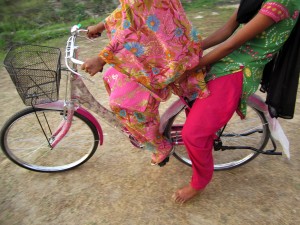 BIHAR, India, April 2012—Imagine that you are a young girl growing up in West Bengal, India. Your village smells of spices, and coconuts and pineapples hang from the trees. Women roam through tea gardens, up to their bellies in leaves that they pluck by the handful and place in bags that rest on little head pillows.
BIHAR, India, April 2012—Imagine that you are a young girl growing up in West Bengal, India. Your village smells of spices, and coconuts and pineapples hang from the trees. Women roam through tea gardens, up to their bellies in leaves that they pluck by the handful and place in bags that rest on little head pillows.

